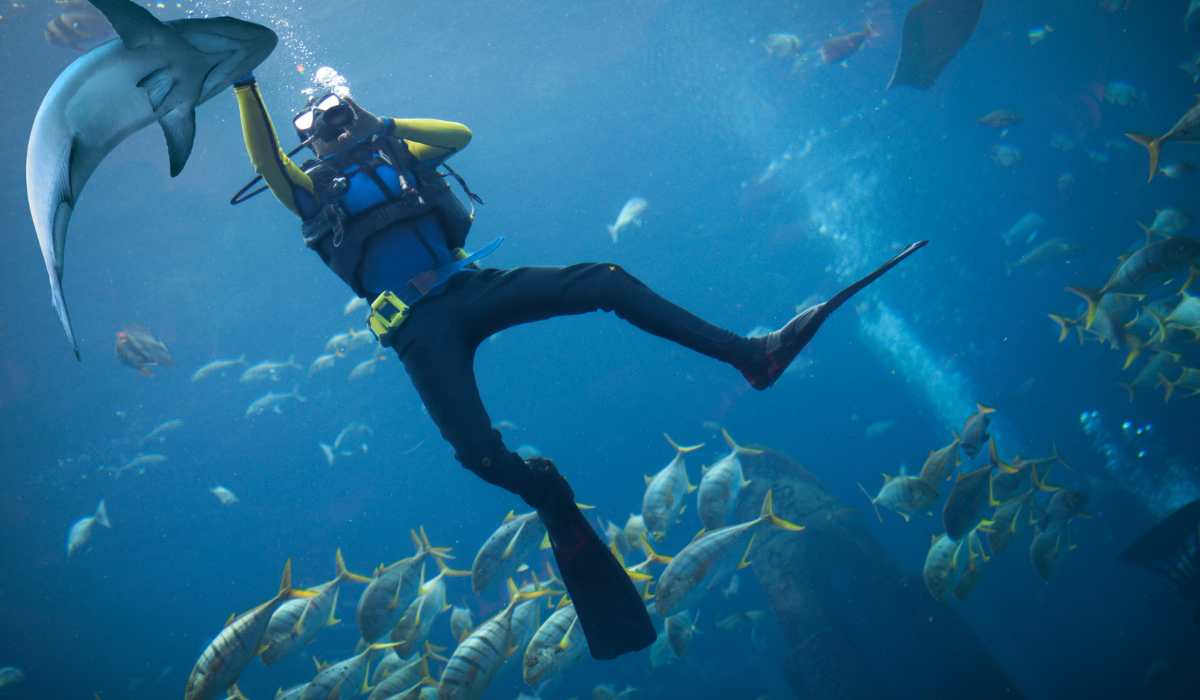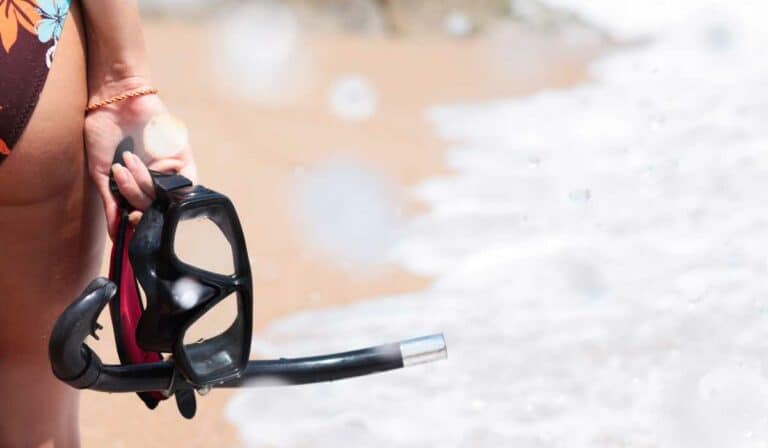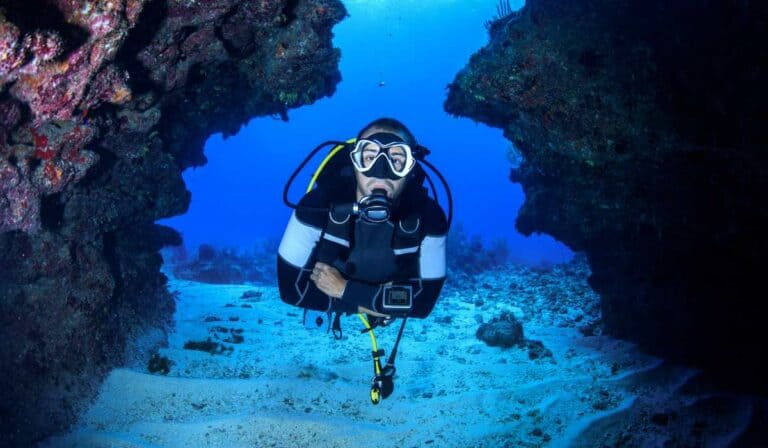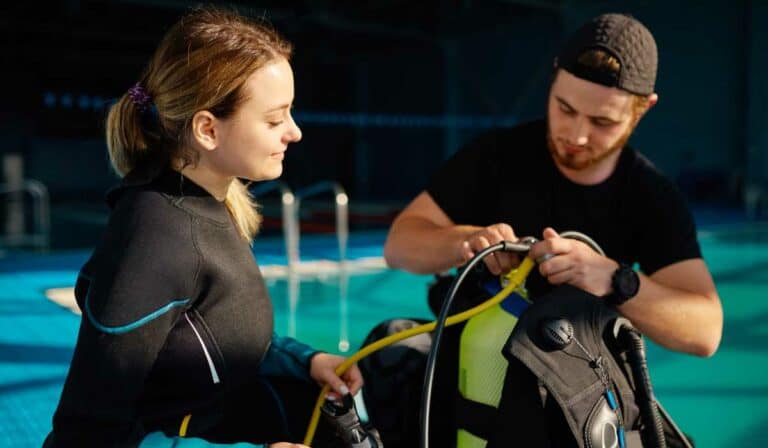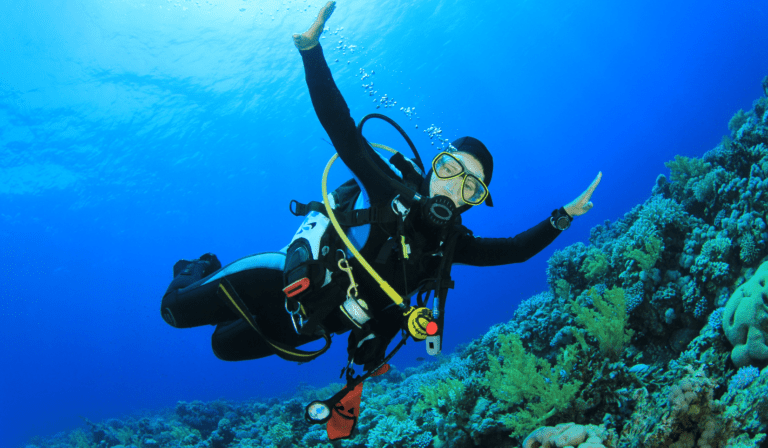How to Scuba Dive with Sharks: A Beginner’s Guide
Are you set to embark on an exciting journey and gain knowledge of scuba diving with sharks? As thrilling as it may be, shark diving requires a thorough understanding of safety measures and proper preparation. In this guide, we will explore the world of scuba diving with sharks.
We’ll begin by discussing essential shark diving safety tips, ensuring that both you and these majestic creatures are protected. Next, we will delve into choosing the perfect dive location based on your experience level and desired interaction with various shark species.
From there, our journey continues as we prepare for the big dive – including gear selection and understanding crucial pre-dive protocols. We’ll then venture into open-water shark diving techniques followed by exploring the adrenaline-pumping experience of cage diving with sharks.
This comprehensive guide to shark scuba diving will equip you with the skills and awareness required for a memorable underwater experience, while also advocating sustainable approaches that safeguard sharks and their habitats.
Table of Contents
1. Understanding Shark Diving Safety
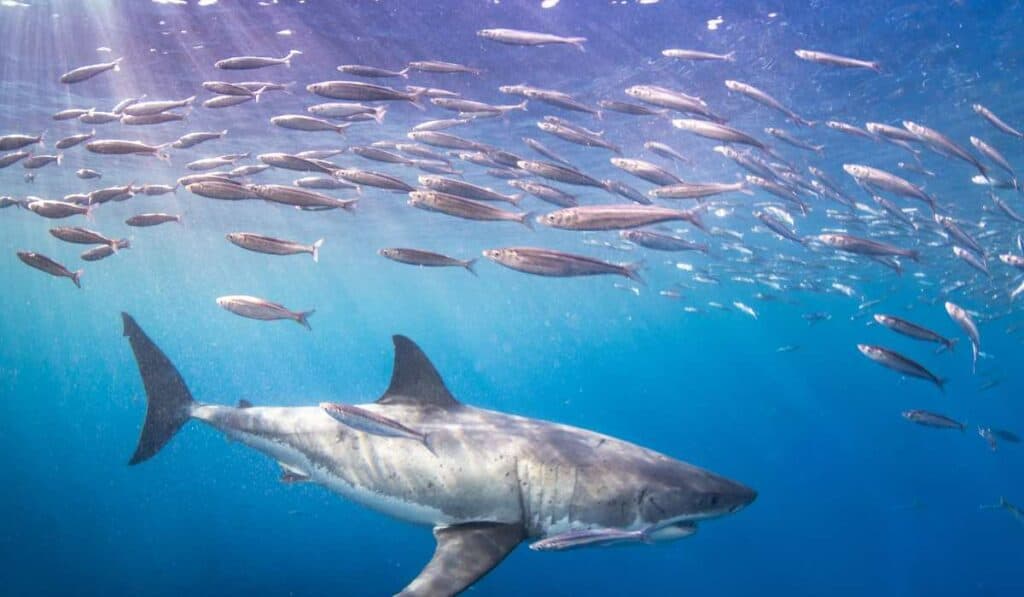
Diving with sharks can be an amazing and remarkable experience, yet it is critical to make sure safety comes first when venturing into the underwater realm of these majestic animals. By following established safety protocols and regulations, you can minimize risks while enjoying a thrilling adventure.
A. Know Your Sharks
Before embarking on your shark diving journey, familiarize yourself with the different types of sharks you may encounter during your dive. Some species are more aggressive than others, so understanding their behavior patterns will help ensure a safer experience.
B. Choose a Reputable Dive Operator
Selecting a reputable dive operator is essential for ensuring that all necessary safety precautions are taken care of before and during your dive. Look for operators with positive reviews from previous divers, as well as certifications from organizations like PADI (Professional Association of Diving Instructors).
i) Check Equipment Quality
- Make sure the operator provides high-quality gear in good condition.
- Inquire about equipment maintenance schedules and practices.
- If possible, opt for operators who use steel cages instead of aluminum ones since they’re stronger and more durable.
ii) Verify Guides’ Experience & Training
- A knowledgeable guide should have extensive experience diving with sharks specifically.
- Ensure guides hold proper certifications such as PADI Divemaster or Instructor credentials.
C. Follow Safety Guidelines & Instructions
Adhering to safety guidelines and instructions provided by your dive operator is crucial for minimizing risks. Some essential tips include:
- Always stay with your group and follow the guide’s lead.
- Do not touch or provoke sharks, as this can trigger aggressive behavior.
- Maintain a safe distance from the sharks – at least three meters (10 feet) away.
- Avoid wearing shiny jewelry or brightly colored clothing, as these can attract sharks.
D. Be Prepared for Emergencies
Although shark attacks on divers are rare, it’s essential to be prepared in case of an emergency. Familiarize yourself with first aid procedures and carry a well-stocked first aid kit during your dive trip. Additionally, ensure that you know how to use signaling devices such as surface marker buoys (SMBs) and whistles in case you need assistance while underwater.
In conclusion, responsible shark diving is possible when scuba divers understand sharks and avoid diving practices that harm them. Protecting shark species through shark conservation efforts like ending shark finning is crucial. By following safety guidelines and instructions, divers can enjoy the thrill of shark diving while minimizing risks to themselves and the sharks.
Understanding shark diving safety is a critical part of having an enjoyable and safe experience. Choosing a spot for diving that matches one’s skill level and comfort is the following move to make in order to have an enjoyable, secure experience.
Key Takeaway:
For a safe shark scuba dive, one should be knowledgeable about the various kinds of sharks and select an established diving business that provides quality gear. Following safety guidelines and instructions such as maintaining a safe distance from the sharks and being prepared for emergencies can help minimize risks while enjoying an exhilarating experience.
Click here to read about World’s Best Quarries for Scuba Diving
2. Choosing a Dive Location
For an unforgettable experience, select a dive site that best suits the type of sharks you wish to encounter and your level of diving expertise. For a successful and memorable shark diving experience, selecting the right destination based on your desired species of sharks to encounter as well as your level of expertise is essential.
Great White Shark Diving Locations
Great white sharks are one of the most popular species for shark divers due to their size and reputation as apex predators. Some top destinations for great white shark diving include:
- Gansbaai, South Africa: Known as “The Great White Shark Capital of The World,” Gansbaai offers incredible cage-diving experiences with these massive predators.
- Isla Guadalupe, Mexico: This remote volcanic island provides crystal-clear waters perfect for observing great whites up close during cage dives.
- Farallon Islands, California: Located just off San Francisco’s coast, this area boasts a healthy population of great whites that can be observed from both cages and boats.
Whale Shark Diving Locations
If swimming alongside gentle giants is more your style, consider diving with whale sharks, which are known for being docile filter-feeders despite their enormous size. Top whale shark dive spots include:
- Ningaloo Reef, Australia: From March to August, whale sharks migrate to this UNESCO World Heritage site for an unforgettable snorkeling experience.
- Utila, Honduras: This small island in the Caribbean is a popular destination for divers seeking close encounters with whale sharks year-round.
- Donsol Bay, Philippines: Between November and June, Donsol Bay offers some of the highest concentrations of whale sharks on Earth.
Other Shark Species Dive Locations
Beyond great whites and whale sharks, there are countless other shark species you can dive with around the world. Some notable locations include:
- Tiger Beach, Bahamas: Famous for its shallow waters teeming with tiger sharks, lemon sharks, and more – perfect for both novice and experienced divers alike.
- Maloelap Atoll, Marshall Islands: Home to grey reef sharks and silky sharks that can be observed during drift dives along coral walls.
- Bull Shark Diving Playa del Carmen Mexico: This location is known specifically as one of the best places to see bull sharks up close from December through March each year.
In conclusion, diving with sharks can be an incredible experience when done responsibly. By choosing a reputable shark diving tourism operator and following guidelines to protect sharks, scuba divers can safely observe and understand these fascinating creatures in their natural habitat.
Selecting a dive destination is an essential factor in any scuba diving excursion, as it can influence the kind and amount of creatures spotted. With proper research and preparation, you will be able to find a great spot for your next underwater exploration. Having settled on a dive location, let us now proceed to make ready for the plunge.
Key Takeaway:
For those wanting to explore the depths with sharks, it’s important to select a suitable spot based on both the type of shark and one’s own diving experience. Great white sharks can be found in Gansbaai, South Africa; Isla Guadalupe, Mexico; and Farallon Islands, California while whale sharks are popularly observed at Ningaloo Reef in Australia, Utila in Honduras, and Donsol Bay in the Philippines. Other species like tiger sharks can be seen at Tiger Beach Bahamas or Maloelap Atoll Marshall Islands while Bull Sharks can be spotted up close from December through March each year at Playa del Carmen Mexico.
Click here to read about The Magic of Scuba Diving – A Beginner’s Guide
3. Preparing for Your Dive
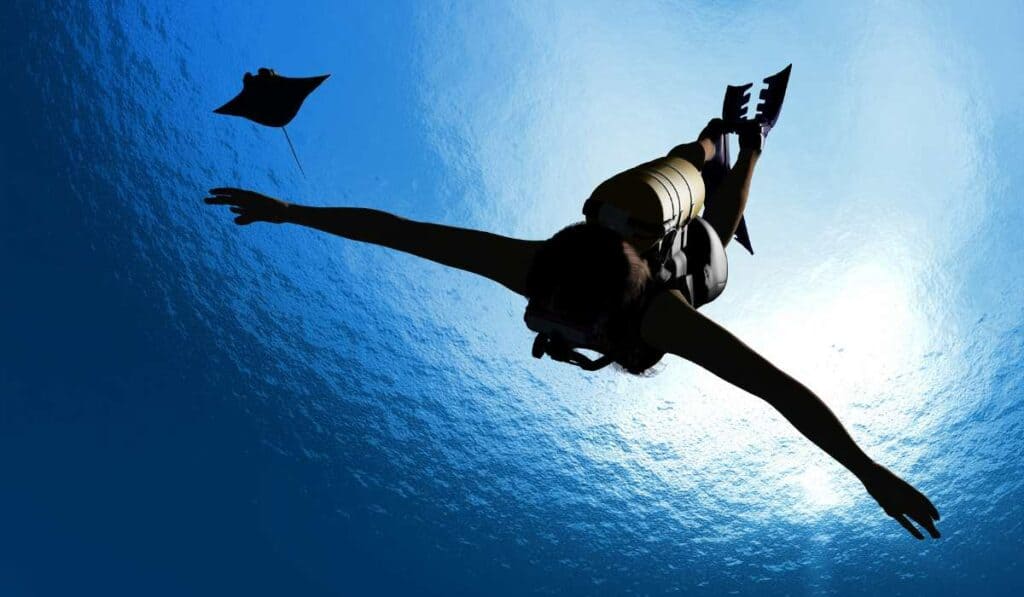
Prior to your thrilling dive with sharks, make sure you are outfitted with the proper supplies and equipment for a secure and enjoyable outing. In this section, we’ll discuss some of the key items you’ll need for both open-water and cage dives with sharks.
A. Scuba Diving Gear
The basic scuba diving gear required for any dive includes:
- Diving mask
- Snorkel
- Fins
- Wetsuit or drysuit (depending on water temperature)
- Buoyancy Control Device (BCD)
- Regulator with alternate air source
- Dive computer or depth gauge/timer combo
- Tank(s) filled with an appropriate gas mixture (air or nitrox)
- Weight system
B. Additional Equipment for Shark Dives
In addition to standard scuba gear, there are specific items that can enhance your safety while diving with sharks:
- A sturdy pair of gloves: These will protect your hands from potential nicks and scratches while handling the cage or other equipment.
- A dive knife: This can be used to cut yourself free if you become entangled in any lines or nets during the dive.
- An underwater camera with a wide-angle lens: Capture stunning images of your shark encounter without disturbing their natural behavior. Check out our recommendations for the best underwater cameras here.
C. Choosing a Reputable Dive Operator
When planning your shark diving adventure, it’s crucial to select a reputable dive operator that prioritizes safety and adheres to local regulations. Research operators thoroughly by reading reviews, asking for recommendations from fellow divers, and verifying their credentials with organizations like PADI (Professional Association of Diving Instructors) or SSI (Scuba Schools International). A good operator will provide thorough briefings on safety procedures, ensure all participants are properly trained and certified for the type of dive being conducted, and maintain well-serviced equipment.
D. Pre-Dive Training & Briefings
Prior to entering the water with sharks, most operators will require some form of pre-dive training or briefing session covering essential topics such as:
- Shark species identification & behavior patterns
- Safety protocols specific to diving with sharks
- The importance of maintaining neutral buoyancy & proper body positioning in open-water dives
- Cage diving procedures, including entering and exiting the cage safely
- Emergency procedures & communication signals
By following these preparation steps and ensuring you have the right gear, knowledge, and support from a reputable dive operator, you’ll be well-equipped for an unforgettable shark diving experience.
4. Preparing for Your Dive
As a responsible diver, you should also be aware of the potential risks associated with shark diving tourism and take steps to protect sharks while understanding their behavior.
Gear and Equipment Checklist
- Scuba Gear: A complete set of scuba gear is crucial for any dive. This includes a mask, snorkel, fins, wetsuit or drysuit (depending on water temperature), the buoyancy control device (BCD), regulator, dive computer, weight system, tank(s), gloves (if needed), and booties.
- Dive Certification Card: Make sure you have your certification card handy as most operators require proof of certification before allowing divers into the water. If you’re not yet certified but want to try shark diving anyway, consider taking an introductory course focused on shark conservation.
- Dive Insurance: It’s always better to be safe than sorry when participating in adventurous activities like scuba diving with sharks. Invest in comprehensive dive insurance, which covers medical expenses related to injuries sustained during dives.
- Coral-Safe Sunscreen: To protect both yourself from sunburns and marine life from harmful chemicals found in regular sunscreen products use coral-safe sunscreen that won’t harm underwater ecosystems.
- A Safety Sausage or Surface Marker Buoy (SMB): This brightly colored inflatable tube helps alert boat traffic above to your presence and location while you’re submerged.
- Underwater Camera: If you want to capture the incredible moments spent with these majestic creatures, bring along a waterproof camera or GoPro. Just remember not to use flash as it can startle sharks and other marine life.
Understanding Shark Behavior
To ensure a safe shark diving experience, it’s essential for scuba divers to understand shark behavior and avoid actions that may attract unwanted attention from these powerful predators. Some tips include:
- Avoid wearing shiny jewelry or bright colors that might mimic small fish and draw the shark’s attention.
- Maintain a calm demeanor in the water; sudden movements can trigger predatory instincts in some species of sharks.
- Keep an eye on your surroundings at all times – be aware of any changes in shark behavior, such as increased speed or erratic swimming patterns which could indicate agitation or stress.
Prior to your dive, it is critical to take the necessary steps for a secure and pleasurable excursion. With the right knowledge and preparation, you can confidently transition into open-water shark diving with ease.
Key Takeaway:
Before taking the plunge with sharks, it is essential to equip oneself with protective gear such as gloves, a dive knife, and an underwater camera. Choose a reputable dive operator that prioritizes safety and provides thorough pre-dive training on shark species identification, behavior patterns, safety protocols specific to diving with sharks, cage diving procedures as well as emergency procedures & communication signals.
Click here to read about Jamaica Scuba Diving Guide: Dive into the Best Underwater World
5. Open Water Shark Diving
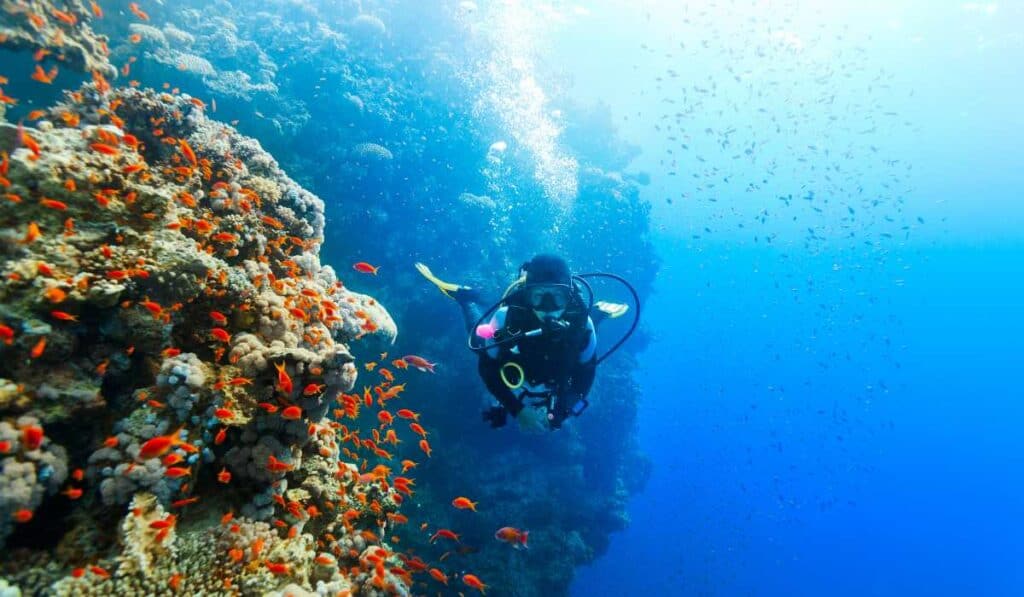
Diving with sharks in the open water is an exhilarating experience that allows you to observe these magnificent creatures up close in their natural habitat. To ensure a safe and enjoyable dive, it’s essential to follow proper guidelines and precautions.
A. Choose the Right Dive Operator
Selecting a reputable dive operator is crucial for your safety and enjoyment during an open-water shark dive. Look for operators with experienced guides who prioritize conservation efforts, adhere to strict safety protocols, and have excellent reviews from previous divers.
B. Learn About Shark Behavior
Understanding shark behavior can help you feel more comfortable during your dive while also ensuring that you respect their space and avoid disturbing them unnecessarily. Take time before your trip to research different types of sharks (such as great white sharks, whale sharks, or reef sharks) so that you know what behaviors are typical for each species.
C. Follow Your Guide’s Instructions
Your guide will provide valuable information about how to interact safely with the local shark population during your pre-dive briefing at SunWaterDirt.com outdoor adventure blog post on diving with great white sharks along whale sharks. Pay close attention, ask questions if needed, and always follow their instructions throughout the entire dive experience.
D. Maintain a Safe Distance
To minimize risk while diving with any type of shark species, it’s essential to maintain a safe distance from these animals. Experts recommend staying at least 3 meters (10 feet) away from sharks and never attempt to touch or feed them.
E. Stay Calm and Composed
It’s essential to keep your composure and avoid letting emotions overwhelm you when embarking on a shark diving adventure. Remaining calm and composed will help ensure your safety as well as that of the sharks around you.
Famous Open Water Shark Diving Locations
- The Bahamas: Known for its crystal-clear waters and abundant shark populations, The Bahamas is an ideal destination for open-water shark diving experiences.
- Guadalupe Island, Mexico: This remote volcanic island off Baja California offers some of the world’s most thrilling encounters with great white sharks in their natural habitat.
- Neptune Islands, Australia: Home to one of Australia’s largest fur seal colonies, Neptune Islands provide divers with incredible opportunities to observe great white sharks up close in clear blue waters.
Diving into open water with sharks provides an exciting, unparalleled chance to come face-to-face with some of the most powerful sea predators. Cage diving with sharks takes it a step further, allowing you to observe these majestic creatures from within their natural habitat.
Key Takeaway:
Open-water shark diving is an exhilarating experience that requires choosing a reputable dive operator, learning about shark behavior, following your guide’s instructions, maintaining a safe distance from the sharks, and staying calm. Some famous open-water shark diving locations include The Bahamas, Guadalupe Island in Mexico, and Neptune Islands in Australia.
6. Cage Diving With Sharks
For the ultimate rush, cage diving with sharks offers an unforgettable opportunity to observe these majestic creatures up close. This thrilling activity allows you to get up close and personal with some of the ocean’s most magnificent predators while ensuring your safety within a sturdy metal cage. Two popular types of shark encounters are great white shark dives and whale shark dives.
A. Great White Shark Cage Dives
Great whites, renowned for their enormity, strength, and sharp-edged teeth, are amongst the most impressive of oceanic creatures. To dive with these apex predators safely, many companies offer guided cage diving experiences that provide both excitement and security.
- Location: Some popular locations for great white shark cage diving include South Africa’s Gansbaai or Mossel Bay, Australia’s Neptune Islands, Guadalupe Island in Mexico, and California’s Farallon Islands.
- Safety Precautions: Professional guides will brief you on all necessary safety precautions before entering the water. It is essential to follow their instructions closely throughout your dive.
- Cage Design: The cages used during these dives are designed specifically to withstand potential impacts from curious sharks while providing clear visibility underwater.
B. Whale Shark Cage Dives
In contrast to great whites’ fearsome reputation, whale sharks, despite being massive fish (the largest species on Earth), pose no threat to humans. These gentle giants are filter feeders, meaning they consume plankton and small fish by filtering water through their gills.
- Location: Some popular destinations for whale shark cage diving include Western Australia’s Ningaloo Reef, Mexico’s Isla Holbox or La Paz, the Philippines’ Donsol Bay, and Honduras’ Utila Island.
- Safety Precautions: While whale sharks are not aggressive towards humans, it is still crucial to follow your guide’s instructions on maintaining a safe distance from these massive creatures during your dive.
- Cage Design: Whale shark cages may be more open than those used for great white dives due to the lower risk associated with these gentle animals. This design allows divers greater freedom of movement while observing the sharks up close.
Click here to read about Is Scuba Diving Dangerous? Exploring Risks and Safety Tips
No matter which type of cage diving experience you choose – whether it’s facing off with powerful great whites or marveling at majestic whale sharks – this unforgettable adventure will leave you in awe of nature’s incredible underwater world. Remember always to prioritize safety and respect for marine life during your dive.
Key Takeaway:
Adrenaline-fuelled diving with sharks is an electrifying way to come face-to-face with some of the ocean’s mightiest creatures while remaining secure in a solid metal enclosure. Great white shark dives and whale shark dives are two popular types of shark encounters, each requiring different safety precautions and cage designs.
7. Follow Safety Guidelines
Always follow the safety guidelines provided by your instructor or guide. Maintain a respectful distance from the sharks and avoid touching them. Always dive with a buddy and be aware of your surroundings at all times during the dive. Avoid wearing shiny objects or bright colors underwater as they may attract the shark’s attention.
FAQs about How to Scuba Dive With Sharks
How to Scuba Dive with Sharks
If you’re an adventurous scuba diver, you may want to try scuba diving with sharks. It’s an exhilarating experience that can be done safely and responsibly. Here are some tips to help you get started.
Choose a Reputable Dive Operator
Research and choose a reputable dive operator that offers shark diving experiences. Look for operators that prioritize diver safety and conservation efforts. Read reviews and ask for recommendations from other scuba divers.
Complete Necessary Training and Certifications
Before diving with sharks, you’ll need to complete the necessary training and certifications for the specific type of shark diving you plan to do. This may include open-water or cage-diving certifications. Make sure you’re comfortable with the required skills and have practiced them before attempting to dive with sharks.
Is it Safe to Scuba Dive with Sharks?
Scuba diving with sharks is generally safe when proper safety precautions and guidelines are followed. The likelihood of encountering a shark while scuba diving depends on factors such as location, time of year, depth of the water, and local marine life population density. Encounters are rare, but it’s important to be prepared and follow safety guidelines.
Is it Ethical to Dive and Swim with Sharks?
Diving ethically involves respecting wildlife, including maintaining appropriate distances from animals without disturbing them. Choose responsible operators committed to sustainable practices and promoting education about these misunderstood creatures rather than exploiting them for profit. By understanding and protecting sharks, we can help conserve these important species for future generations.
Conclusion
Exploring the depths beneath the sea alongside sharks can be an electrifying and remarkable adventure. By understanding shark diving safety, choosing the right dive location, preparing for your dive, and deciding between open water or cage diving, you can have a safe and enjoyable encounter with these magnificent creatures.
It’s important to remember that responsible shark tourism involves protecting sharks and their habitats while also educating ourselves about these misunderstood species.

